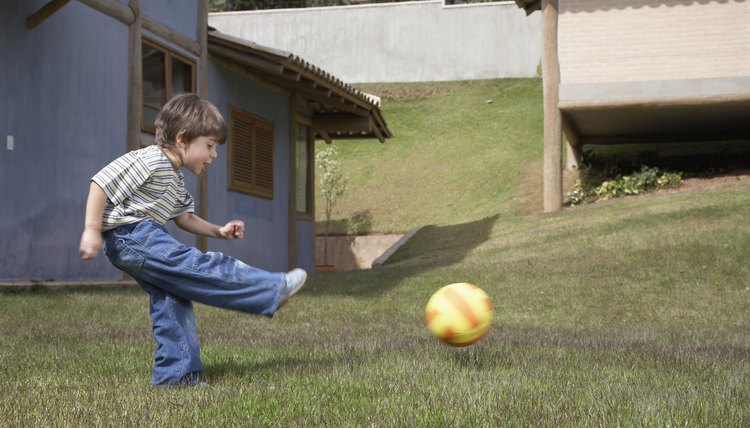How Do Your Muscular & Skeletal Systems Help You Kick a Soccer Ball?

A 4-year-old can manage to amble up and lightly tap a soccer ball, while an elite player can scorch it at 70 mph into the corner of the net past the goalkeeper’s extended hands. The strongest skeletal muscle in the body, the quadriceps, gets ample help from muscles elsewhere to create an explosive impact of shoe on ball and blast it so it can raise a team’s fortunes.
Stages
The biomechanics of kicking a soccer ball involves stages, beginning with the approach as you run up to the ball. Your plant foot digs into the ground a foot to the side of the ball, and the heel of your kicking foot swings back almost to touch the buttocks in a process called swing-limb loading. All that energy gathers as the hip flexes and knee extends, followed by foot contact with the ball and follow-through. Your torso leans back, and the kicking foot rises to around chest level.
Features
The knee extensors, which work to straighten the lower leg, display maximum eccentric activity, meaning activity while lengthening, during swing-limb loading. Your body prepares to transfer as much force as possible to the ball. The extensors next powerfully contract to swing the foot to the ball. At the time of foot contact, 15 percent of the energy of the swinging leg transfers to the ball, and your hamstring uses the rest to slow the limb down. Follow-through lengthens the time your foot stays in contact with the ball and serves to avoid injury as the forces of the kicking motion dissipate.
Muscular Actors
In a right-footed kick, the abdominals, erector spinae and psoas major stabilize the trunk. Right hip flexion or bending is controlled by the rectus femoris, the psoas, the iliacus, adductor group and sartorius, an oblique muscle on the inside of the thigh associated with sitting cross-legged. The extension of the left hip is guided by the largest muscle in the body, the gluteus. The powerful quadriceps extends the left and right knees, while the plantarflexors flex the right ankle. The anterior deltoid, biceps brachii and pectoralis major move the left shoulder toward the midline of the body. During follow-through, the hamstrings, gluteus and nearby piriformis rotate and extend the right hip, while the hamstring group flexes the right knee.
Supporting Factors
Sense organs within the joints, tendons and muscles provide information to the central nervous system about their motions, so the body can act on this feedback to control the joint angles and muscular involvement during the kick and address the ball correctly. The hips rotate through the front and horizontal planes. The knee typically goes through 140 degrees of flexion and extension. The arms, extended to the sides, work to help you keep your balance by placing your center of gravity over your support foot.
References
Writer Bio
An award-winning writer and editor, Rogue Parrish has worked at the Washington Post, the Baltimore Sun and at newspapers from England to Alaska. This world adventurer and travel book author, who graduates summa cum laude in journalism from the University of Maryland, specializes in travel and food -- as well as sports and fitness. She's also a property manager and writes on DIY projects.
